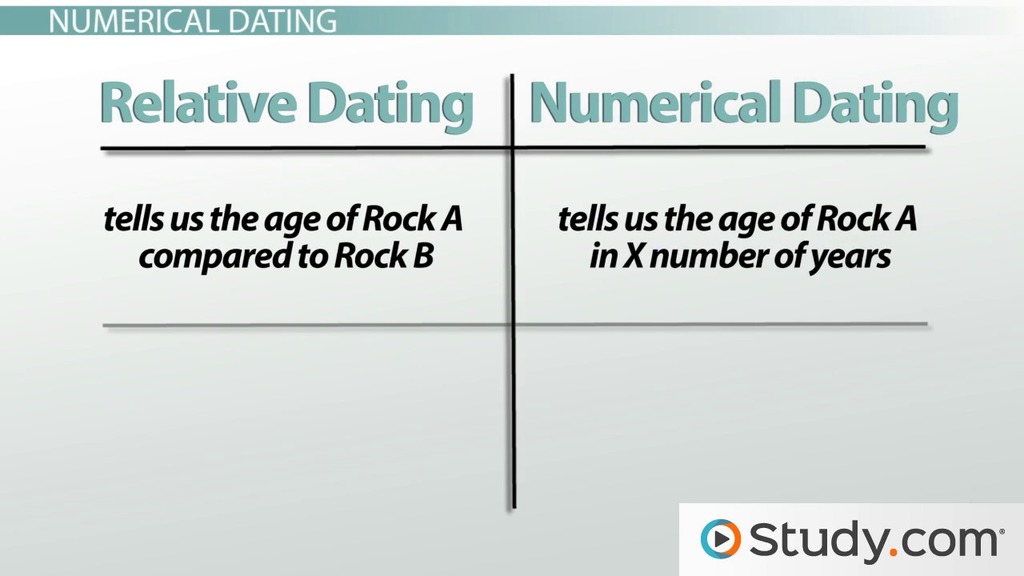Methods of Geological Dating: Numerical and Relative Dating
What is Relative Dating? Are you still watching? Your next lesson will play in 10 seconds. Add to Add to Add to. Want to watch this again later? Numerical and Relative Geological Dating. Principles of Radiometric Dating. Relative Dating with Fossils: Index Fossils as Indicators of Time. Ocean Drilling as Evidence for Plate Tectonics. Absolute Time in Geology. What is Relative Age? Major Triggers for Mass Wasting: Base Level of a Stream: Classification of Metamorphic Rocks: Introduction to Physical Geology: Intro to Natural Sciences.
Middle School Earth Science: Weather and Climate Science: UExcel Weather and Climate: Guns, Germs, and Steel Study Guide.
What is the difference between absolute age and relative age of fossils?
Holt McDougal Introduction to Geography: April Koch April teaches high school science and holds a master's degree in education. Learn how scientists determine the ages of rocks and fossils.
Dating Dinosaur Fossils Consider the following scenario: Relative Dating The first method that scientists use to determine the age of rocks is relative dating. Fossil succession can be used to determine the relative ages of fossils. Numerical Dating Stratigraphic and fossil succession are good tools for studying the relative dates of events in Earth's history, but they do not help with numerical dating.
Try it risk-free No obligation, cancel anytime.
Want to learn more? Select a subject to preview related courses: Lesson Summary In reality, scientists use a combination of relative and numerical dating to establish the ages of rocks and fossils. Learning Outcomes Following this video lesson, you will be able to: Describe the relative dating processes of stratigraphic succession and fossil succession Explain how scientists use radioactive decay for numerical dating Summarize how and why scientists use a combination of relative and numerical dating when it comes to rocks and fossils.

Unlock Your Education See for yourself why 30 million people use Study. Become a Member Already a member? Earning College Credit Did you know… We have over college courses that prepare you to earn credit by exam that is accepted by over 1, colleges and universities.
- Relative Vs. Absolute Dating: The Ultimate Face-off!
- Report Abuse.
- dating finland man.
To learn more, visit our Earning Credit Page Transferring credit to the school of your choice Not sure what college you want to attend yet? Browse Articles By Category Browse an area of study or degree level. Women in the Sciences Space Scientist: You are viewing lesson Lesson 3 in chapter 2 of the course:. Earth Science 24 chapters lessons 16 flashcard sets. Earth's Spheres and Internal Rock Deformation and Mountain Water Balance on Earth. Studying for Earth Science High School Physical Chemistry: Prep and Practice Molecular Biology: Browse by Lessons What is the Dissociation Constant?
Organization of Matter General Science: Characteristics of Matter General Science: Atomic Structure General Science: Nuclear Chemistry General Science: Latest Courses Computer Science Popular Lessons Nodes of Ranvier: Create an account to start this course today.
You must create an account to continue watching
Note that in the United States it is common to break the Carboniferous into two periods, the Pennsylvanian and the Mississippian, as is done in our museum. The Museum thanks Dr.

Andrew MacRae for the use of the time scale image and the short essay below. Few discussions in geology can occur without reference to geologic time. Related questions What is the principle of Uniformitarianism and how is it important to the relative dating of rocks? What is the age of inclusions found in a rock relative to the rock in which they are found?
What is the difference between absolute age and relative age of fossils? | Socratic
What is the principle of cross-cutting relations and why is it important for relative dating? What forces can disturb relative dating? What is the law of superposition and how can it be used to relatively date rocks? What is meant by dating rocks relatively rather than absolutely? How can fossils be used to determine the relative ages of rock layers? How does the law of crosscutting relationships help scientists determine the relative age of rocks?